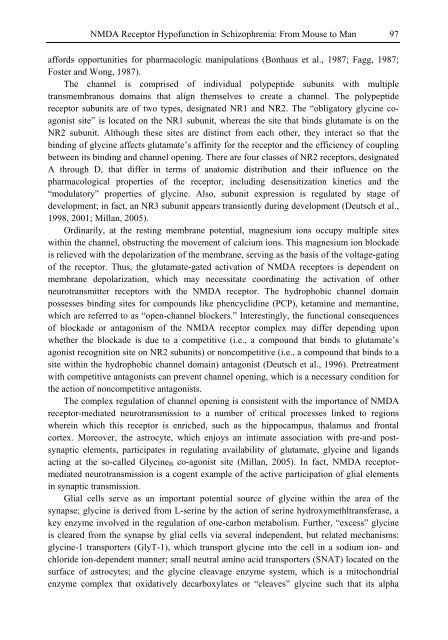Schizophrenia Research Trends
Schizophrenia Research Trends
Schizophrenia Research Trends
- No tags were found...
Create successful ePaper yourself
Turn your PDF publications into a flip-book with our unique Google optimized e-Paper software.
NMDA Receptor Hypofunction in <strong>Schizophrenia</strong>: From Mouse to Man 97affords opportunities for pharmacologic manipulations (Bonhaus et al., 1987; Fagg, 1987;Foster and Wong, 1987).The channel is comprised of individual polypeptide subunits with multipletransmembranous domains that align themselves to create a channel. The polypeptidereceptor subunits are of two types, designated NR1 and NR2. The “obligatory glycine coagonistsite” is located on the NR1 subunit, whereas the site that binds glutamate is on theNR2 subunit. Although these sites are distinct from each other, they interact so that thebinding of glycine affects glutamate’s affinity for the receptor and the efficiency of couplingbetween its binding and channel opening. There are four classes of NR2 receptors, designatedA through D, that differ in terms of anatomic distribution and their influence on thepharmacological properties of the receptor, including desensitization kinetics and the“modulatory” properties of glycine. Also, subunit expression is regulated by stage ofdevelopment; in fact, an NR3 subunit appears transiently during development (Deutsch et al.,1998, 2001; Millan, 2005).Ordinarily, at the resting membrane potential, magnesium ions occupy multiple siteswithin the channel, obstructing the movement of calcium ions. This magnesium ion blockadeis relieved with the depolarization of the membrane, serving as the basis of the voltage-gatingof the receptor. Thus, the glutamate-gated activation of NMDA receptors is dependent onmembrane depolarization, which may necessitate coordinating the activation of otherneurotransmitter receptors with the NMDA receptor. The hydrophobic channel domainpossesses binding sites for compounds like phencyclidine (PCP), ketamine and memantine,which are referred to as “open-channel blockers.” Interestingly, the functional consequencesof blockade or antagonism of the NMDA receptor complex may differ depending uponwhether the blockade is due to a competitive (i.e., a compound that binds to glutamate’sagonist recognition site on NR2 subunits) or noncompetitive (i.e., a compound that binds to asite within the hydrophobic channel domain) antagonist (Deutsch et al., 1996). Pretreatmentwith competitive antagonists can prevent channel opening, which is a necessary condition forthe action of noncompetitive antagonists.The complex regulation of channel opening is consistent with the importance of NMDAreceptor-mediated neurotransmission to a number of critical processes linked to regionswherein which this receptor is enriched, such as the hippocampus, thalamus and frontalcortex. Moreover, the astrocyte, which enjoys an intimate association with pre-and postsynapticelements, participates in regulating availability of glutamate, glycine and ligandsacting at the so-called Glycine B co-agonist site (Millan, 2005). In fact, NMDA receptormediatedneurotransmission is a cogent example of the active participation of glial elementsin synaptic transmission.Glial cells serve as an important potential source of glycine within the area of thesynapse; glycine is derived from L-serine by the action of serine hydroxymethltransferase, akey enzyme involved in the regulation of one-carbon metabolism. Further, “excess” glycineis cleared from the synapse by glial cells via several independent, but related mechanisms:glycine-1 transporters (GlyT-1), which transport glycine into the cell in a sodium ion- andchloride ion-dependent manner; small neutral amino acid transporters (SNAT) located on thesurface of astrocytes; and the glycine cleavage enzyme system, which is a mitochondrialenzyme complex that oxidatively decarboxylates or “cleaves” glycine such that its alpha
















